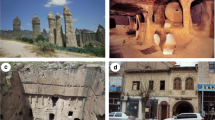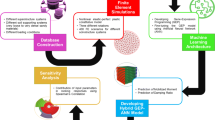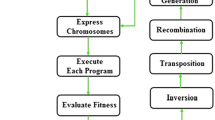Abstract
In this paper, two soft computing approaches, which are known as artificial neural networks and Gene Expression Programming (GEP) are used in strength prediction of basalts which are collected from Gaziantep region in Turkey. The collected basalts samples are tested in the geotechnical engineering laboratory of the University of Gaziantep. The parameters, “ultrasound pulse velocity”, “water absorption”, “dry density”, “saturated density”, and “bulk density” which are experimentally determined based on the procedures given in ISRM (Rock characterisation testing and monitoring. Pergamon Press, Oxford, 1981) are used to predict “uniaxial compressive strength” and “tensile strength” of Gaziantep basalts. It is found out that neural networks are quite effective in comparison to GEP and classical regression analyses in predicting the strength of the basalts. The results obtained are also useful in characterizing the Gaziantep basalts for practical applications.













Similar content being viewed by others
References
ISRM (1981) Rock characterisation testing and monitoring. In: Brown ET (ed) Pergamon Press, Oxford
Fener M, Kahraman S, Bilgil A, Gunaydin O (2005) A comparative evaluation of indirect methods to estimate the compressive strength of rocks. Rock Mech Rock Eng 38:329–343. doi:10.1007/s00603-005-0061-8
Singh VK, Singh D, Singh TN (2001) Prediction of strength properties of some schistose rocks from petrographic properties using artificial neural networks. Int J Rock Mech Min Sci 38:269–284. doi:10.1016/S1365-1609(00)00078-2
Meulenkamp F (1997) Improving the prediction of the UCS, by equotip readings using statistical and neural network models. Mem Cent Eng Geol Neth 162:127
Meulenkamp F, Alveraz GM (1999) Application of neural networks for the prediction of the unconfined compressive strength (UCS) from equotip hardness. Int J Rock Mech Min Sci 36:29–39. doi:10.1016/S0148-9062(98)00173-9
Nie X, Zhang Q (1994) Prediction of rock mechanical behaviour by artificial neural network. A comparison with traditional method. In IV CSMR, Integral Approach to Applied Rock Mechanics, Santiago, Chile
Garret JH Jr (1994) Where and why artificial neural networks are applicable in civil engineering. J Comput Civ Eng 8:129–130. doi:10.1061/(ASCE)0887-3801(1994)8:2(129)
Tolun N, Pamir HN (1975) Explanatory text of the geological map of Turkey-Hatay. MTA (General Directorate of Mineral Research and Exploration), Ankara
MTA (General Directorate of Mineral Research and Exploration) (1994) Geological Map of the Gaziantep-K24 Quadrangle. Ankara, Turkey
Shakoor A, West TR, Scholer CF (1982) Physical characteristics of some Indiana argillaceous carbonates regarding their freeze thaw resistance in concrete. Bull Assoc Eng Geol 19:371–384
ASTM C127 (1997) Specific gravity and absorption of coarse aggregate
BSI (1983) British specification for aggregates from natural sources for concrete. BS 882: 1983. British Standards Institution, London
Birch F (1961) The velocity of compressional waves in rocks 10 kbars. J Geophys Res 66(Part 2):2199–2224. doi:10.1029/JZ066i007p02199
Ramamurthy T, Arora VK (1993) A classification for intact and jointed rocks. In: Anagnostopoulos A et al (eds) Geotechnical Engineering of Hard Soils–Soft Rocks. A.A. Balkema, Rotterdam, pp 235–242
Hsu S-C, Nelson PP (2002) Characterization of eagle ford shale. Eng Geol 67:169–183. doi:10.1016/S0013-7952(02)00151-5
Baykasoğlu A, Dereli T, Tanış S (2004) Prediction of cement strength using soft computing techniques. Cement Concr Res 34:2083–2090. doi:10.1016/j.cemconres.2004.03.028
Venkatesan D, Kannan K, Saravanan R (2008) A genetic algorithm-based artificial neural network model for the optimization of machining processes. Neural Comput Appl. doi:10.1007/s00521-007-0166-y
Ferreira C (2001) Gene expression programming: a new adaptive algorithm for solving problems. Complex Syst 13:87–129
Koza JR (1992) Genetic programming: on the programming of computers by means of natural selection. MIT Press, Cambridge
Goldberg D (1989) Genetic algorithms in search, optimization and machine learning. Addison-Welsley, MA
Zhou C, Xiao W, Tirpak TM, Nelson PC (2002) Discovery of classification rules by using gene expression programming, In: the proceedings of the 2002 international conference on artificial intelligence (IC-AI’02), Las Vegas, June, pp 1355–1361
Dereli T, Baykasoğlu A (2000) The use of artificial intelligence techniques in design and manufacturing. A review. Gazi Univ J Polytechnic 3:27–60
Zupan J, Gasteiger J (1993) Neural networks for chemists. VCH Publishers, NY
Wang D (1993) Pattern recognition: neural networks in perspective. IEEE Expert (August):52–60. doi:10.1109/64.223991
Nielsen DH (1988) Neurocomputing: picking the human brain. IEEE Spectr 25:36–41. doi:10.1109/6.4520
Kohonen T (1988) An introduction to neural computing. Neural Netw 1:3–16. doi:10.1016/0893-6080(88)90020-2
Elmas Ç (2003) Yapay Sinir Ağları. Ankara. Seçkin Yayıncılık
Ergün M (1995) SPSS for Windows. Ankara, Ocak Yayınları
NeuroDimension Company. http://www.neurosolutions.com
NeuNet Pro 2.2. http://www.cormactech.com/neunet
Acknowledgments
Prof. Dr. Adil Baykasoğlu is grateful to Turkish Academy of Sciences (TÜBA) for supporting his scientific studies.
Author information
Authors and Affiliations
Corresponding author
Rights and permissions
About this article
Cite this article
Çanakcı, H., Baykasoğlu, A. & Güllü, H. Prediction of compressive and tensile strength of Gaziantep basalts via neural networks and gene expression programming. Neural Comput & Applic 18, 1031–1041 (2009). https://doi.org/10.1007/s00521-008-0208-0
Received:
Accepted:
Published:
Issue Date:
DOI: https://doi.org/10.1007/s00521-008-0208-0




